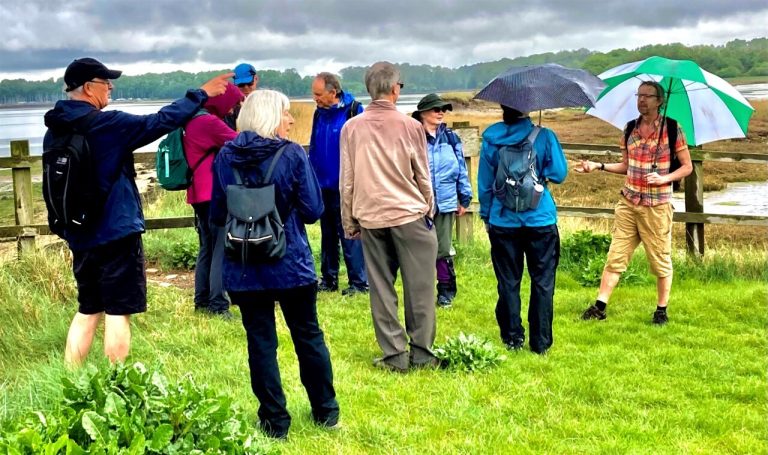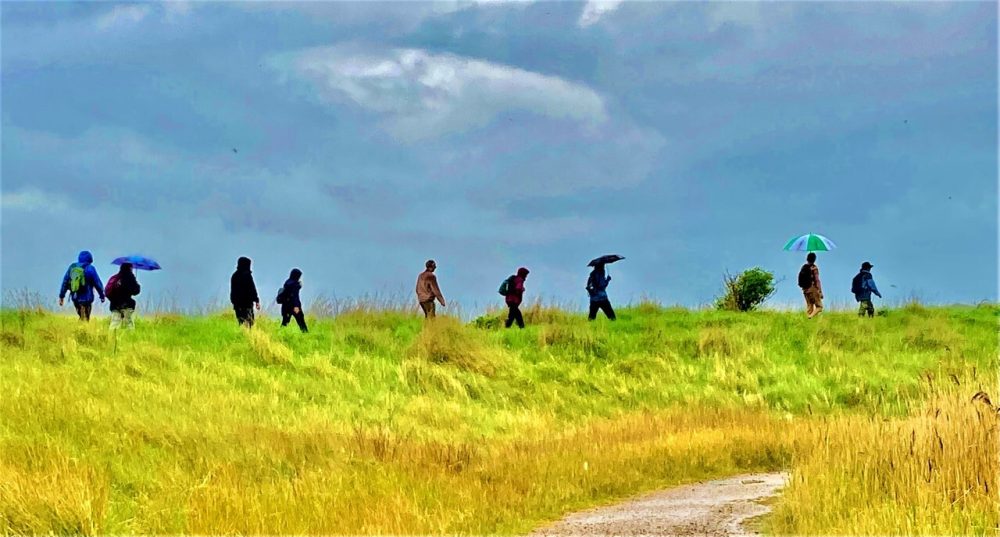Text and photos by Patrick Meehan
After a prompt 10:30AM start from the car park half-way down Cordy’s Lane, Angela Bell led her merry band of nine IOG companions into what would be a varied circular walk of approximately six miles. Although the temperature was a mild 13°C, there was an imminent threat of rain in the low cloud ceiling – which prompted some pre-emptive wearing of wet gear, and the strapping of umbrellas to backpacks.

From the car park we followed the track and signs for Trimley Marshes Nature Reserve, shortly to arrive at Fagbury Point on the River Orwell, where there were views over the Port of Felixstowe whose iconic cranes dominated the grey skyline. Shotley Peninsula lay directly opposite, across the river, which was at ebb tide.

The Suffolk County Council (SCC) leaflet for the walk (see hereunder), tells us: “The Port of Felixstowe has been a working dock for over 125 years. A dock was first constructed here in 1882 opening for trade 4 years later when its first commercial ship arrived in 1886. Today it is the UK’s busiest container port, employing over 3,000 people, handling over 3 million containers per year (40% of the UK’s container cargo) and capable of accommodating some of the world’s largest container ships.”
Continuing due north along the raised bank towards Loompit Lake, the leaden skies were not long in keeping their promise – and opened with an overture of torrential rain. We responded with the swift pulling on and zipping up of all available rain gear, and the blooming of umbrellas popping open like talismans against the angry sky.
Just in case there was an oratorio of thunder and lightning to follow – where the lightning might pose a threat in such an exposed position – Angela led us to temporary shelter in an unattended Visitor Centre which was conveniently located just off the raised bank, and conveniently open. The centre had toilet facilities and a variety of free leaflets, as well as some books for sale via an ‘Honesty Box’.

After the rain abated, we pushed on, rounding Loompit Lake – which the SCC leaflet tells us “was formed by the devastating floods of 1953, a combination of high spring tides and a storm surge which caused sea levels to rise over 5m above normal levels. The surge travelled down the Suffolk coast causing flooding and damaging properties. At Loompit, the flood breached the sea wall to create a lake.”

Beyond the lake we pressed on towards Thorpe Common, then turned due east. Upon reaching Goslings Farm we turned south along a pine-tree lined trail, and near Alston Hall we came upon a gloriously verdant, emerald-green lane, where trees and shrubs crowded in from all sides, and serried hosts of cow parsley eagerly pushed their delicate, umbrella-like clusters of white flowers and fern-like foliage onto the track – as if hoping for a touch from a passer-by perhaps, or offering a healing touch; the leaves and stems of cow parsley are said to have anti-inflammatory, antibacterial and antiviral properties.
And if you stood still for a moment and listened, you might hear nature’s Concert for Spring: The orchestrating wind rippled and weaved through the trees, setting their leaves a-dancing, their branches swaying, creaking and moaning; singing their secrets of the earth. From all around came the drip, drip, drip – constant as a metronome – of precipitation from the higher canopy onto the lower shrub layer and woodland floor, where you could almost hear the ground sighing with appreciation after so many weeks without rain.
From further away, perhaps towards the edge of the wood, came the unmistakable drumming of a tireless woodpecker playing its part in the ensemble in a variety of rhythms and tempos. And in perfect, joyous counterpoint; the chorus of the songbirds – the thrushes, robins and blackbirds – who sang their hearts out, as if expressing their deepest gratitude for being alive on such a wonderful, overcast, rainy day in Suffolk.

South of Grimston Hall we came to a viewpoint over the Trimley Estate, which covers c. 3,400 acres and is the largest single landholding on the Felixstowe peninsula. The estate has been owned by Trinity College, Cambridge, since 1933.
After the walk – and whilst we enjoyed a welcome drink in the nearby Hand in Hand Pub at Trimley St Martin – Angela informed us that Trimley Marshes Nature Reserve was created in 1990 to mitigate against the loss of the Fagbury mudflats as a result of the expansion of the neighbouring Port of Felixstowe. The marshes are known for the sheer number and species of birds: wigeon, brent goose, redshank, avocet, tufted duck, ringed plover, common sandpiper, curlew, oystercatcher, reed and sedge warbler.
For more information on the marshes: https://www.suffolkwildlifetrust.org/trimleymarshes
